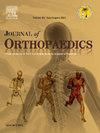Is calcification integral to enthesopathy and tendinopathy rather than a separate disease process?
IF 1.5
Q3 ORTHOPEDICS
引用次数: 0
Abstract
Background
The pathophysiology of enthesopathy and tendinopathy is mucoid degeneration, which includes chondroid metaplasia. The chondroid metaplasia can be associated with calcification. Inflammation is typically absent unless calcification triggers a self-limited immune response representing acute calcific tendinitis. It is therefore important to address the hypothesis that calcific deposits within various entheses and tendons throughout the body are an inconsequential epiphenomenon of enthesopathy and tendinopathy and do not merit a distinct diagnosis or specific treatment.
Methods
We searched PubMed, Embase, and Web of Science for studies that address the prevalence of calcium in tendons and entheses with or without symptoms of tendinopathy, specifically excluding likely acute calcific tendinitis, and analyzed 35 studies meeting inclusion and exclusion criteria. Response variables included prevalence of calcification in and enthesis or tendon among people with no symptoms, among people seeking care for symptoms, and in the opposite asymptomatic limb, and the association between calcification and rotator cuff degeneration.
Results
Calcification of tendons and entheses was present on between 2.7 % and 8.6 % of radiographs of the shoulder, elbow, and ankle among people without symptoms and not seeking care, with higher percentages in older populations. Calcification was common among patients with symptoms: 44 % for rotator cuff tendinopathy, 25 % for enthesopathy of the origin of the extensor carpi radialis brevis, and 53 % for medial elbow enthesopathy. Most people with calcification had it bilaterally. Among people with calcification of the rotator cuff on MRI, nearly all of them (96 %) had tendon degeneration.
Conclusions
The collective evidence regarding calcification in tendons and entheses suggests that it is related to mucoid degeneration and is not a separate disease process. Acute calcific tendinitis rapidly runs its course and is treated only to alleviate symptoms. It's not clear that acute calcific tendinitis or rotator cuff tendinopathy with calcification benefit from specific treatment of the calcium deposits.
Level of evidence
Not applicable.
钙化是贯穿于腱鞘病和肌腱病而不是一个单独的疾病过程吗?
背景:肌腱和肌腱病的病理生理学是粘液变性,其中包括软骨变性。软骨变性可能与钙化有关。除非钙化引发代表急性钙化性肌腱炎的自限性免疫反应,否则炎症通常是不存在的。因此,有一种假说认为,全身各种肌腱和肌腱内的钙化沉积是肌腱病和肌腱病的一种无关紧要的表象,不值得单独诊断或特殊治疗,这种假说有必要加以探讨:我们在PubMed、Embase和Web of Science上搜索了有关肌腱和肌腱内钙质流行率的研究,无论是否伴有肌腱病症状,特别是排除了可能的急性钙化性肌腱炎,并分析了35项符合纳入和排除标准的研究。响应变量包括无症状者、因症状就医者和无症状对侧肢体的肌腱和内膜钙化发生率,以及钙化与肩袖退化之间的关联:在无症状且未就医的人群中,2.7%至8.6%的肩部、肘部和踝部X光片显示肌腱和关节钙化,老年人群的比例更高。钙化在有症状的患者中很常见:肩袖肌腱病变的钙化率为 44%,桡骨外展肌腱起源处粘连病变的钙化率为 25%,肘关节内侧粘连病变的钙化率为 53%。大多数钙化患者都是双侧钙化。在核磁共振成像显示肩袖钙化的患者中,几乎所有人(96%)都有肌腱变性:有关肌腱和粘膜钙化的综合证据表明,钙化与粘液变性有关,并不是一种独立的疾病过程。急性钙化性肌腱炎病程迅速,治疗仅能缓解症状。目前尚不清楚急性钙化性肌腱炎或伴有钙化的肩袖肌腱病是否能从特定的钙沉积治疗中获益:证据等级:不适用。
本文章由计算机程序翻译,如有差异,请以英文原文为准。
求助全文
约1分钟内获得全文
求助全文
来源期刊

Journal of orthopaedics
ORTHOPEDICS-
CiteScore
3.50
自引率
6.70%
发文量
202
审稿时长
56 days
期刊介绍:
Journal of Orthopaedics aims to be a leading journal in orthopaedics and contribute towards the improvement of quality of orthopedic health care. The journal publishes original research work and review articles related to different aspects of orthopaedics including Arthroplasty, Arthroscopy, Sports Medicine, Trauma, Spine and Spinal deformities, Pediatric orthopaedics, limb reconstruction procedures, hand surgery, and orthopaedic oncology. It also publishes articles on continuing education, health-related information, case reports and letters to the editor. It is requested to note that the journal has an international readership and all submissions should be aimed at specifying something about the setting in which the work was conducted. Authors must also provide any specific reasons for the research and also provide an elaborate description of the results.
 求助内容:
求助内容: 应助结果提醒方式:
应助结果提醒方式:


